4 Different Types Of Fronts
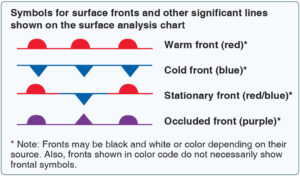 There are 4 basic types of fronts, each with its ain distinct atmospheric condition characteristics. Agreement the differences can help pilots guess how presently weather condition changes will occur and when inclement weather may make it, dissipate, or increase in severity. This weblog explains the four basic fronts that exist within our atmosphere.
There are 4 basic types of fronts, each with its ain distinct atmospheric condition characteristics. Agreement the differences can help pilots guess how presently weather condition changes will occur and when inclement weather may make it, dissipate, or increase in severity. This weblog explains the four basic fronts that exist within our atmosphere.
Warm Forepart
Warm fronts are boundaries of slow-moving air masses that supervene upon masses of colder air ahead of them. Warm fronts typically travel between 10 and 25 miles per hour and contain warm, humid air. As the warm air is lifted, the temperature drops and condensation occurs, forming clouds.
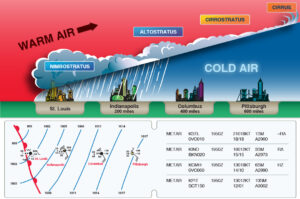 Warm fronts typically have a gentle gradient, so the warm air rising along the frontal surface is gradual. An indication of an approaching warm front is the formation of cirriform or stratiform clouds, along with fog, alee of the frontal purlieus. Cumulonimbus clouds often form in the summertime months when the potential for an unstable lapse charge per unit is high. Recall that the three ingredients for thunderstorms to form are sufficient moisture, an unstable lapse rate, and lifting activity. A warm air mass oft includes the showtime two ingredients, and the lifting action is caused past warm air flowing over the cooler air ahead of the front, as depicted in the effigy above.
Warm fronts typically have a gentle gradient, so the warm air rising along the frontal surface is gradual. An indication of an approaching warm front is the formation of cirriform or stratiform clouds, along with fog, alee of the frontal purlieus. Cumulonimbus clouds often form in the summertime months when the potential for an unstable lapse charge per unit is high. Recall that the three ingredients for thunderstorms to form are sufficient moisture, an unstable lapse rate, and lifting activity. A warm air mass oft includes the showtime two ingredients, and the lifting action is caused past warm air flowing over the cooler air ahead of the front, as depicted in the effigy above.
Light to moderate precipitation in the grade of rain, sleet, snow, or drizzle often occurs, along with poor visibility. Since warm air is less dense than cold air, the barometric pressure first falls, rises slightly, and and then continues to fall until the warm front passes completely.
Cold Front
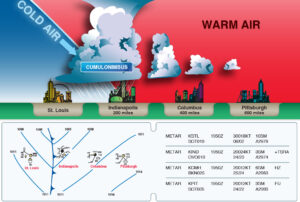 Cold fronts, on the other paw, travel more speedily than warm fronts, at a rate of 25 to 30 miles per 60 minutes (potentially upwards to 60 miles per hour). Cold fronts are dense masses of air that remain close to the ground and readapt warmer air past sliding nether information technology. The ascending air chop-chop decreases in temperature, forming clouds.
Cold fronts, on the other paw, travel more speedily than warm fronts, at a rate of 25 to 30 miles per 60 minutes (potentially upwards to 60 miles per hour). Cold fronts are dense masses of air that remain close to the ground and readapt warmer air past sliding nether information technology. The ascending air chop-chop decreases in temperature, forming clouds.
Alee of a cold front, cirriform, towering cumulus clouds, and cumulonimbus clouds may form. Astringent weather is more common during a cold forepart passage and may include rapid development of heavy rain showers, lightning, hail, and/or tornadoes. Eventually, practiced visibility prevails once the cold air dominates the area. Temperatures remain cooler, and considering cold air is more dense, the barometric pressure continues to ascent.
Sure cold fronts may be fast-moving fronts, and the friction between the ground and the cold front creates a steeper frontal surface, forming a narrow ring of weather concentrated along the leading edge of the front. In light of this, a continuous line of thunderstorms, or squall line, may course along or ahead of the front. Squall lines are a serious hazard to pilots, as squall-type thunderstorms tin can extend well above the capability of many airplanes and can extend in a line stretching 300 to 500 miles, making them hard to navigate effectually. As such, flight through a line of thunderstorms or a squall line should exist avoided. Flying over the summit of or around squall lines is usually not an selection. Even so, since they are fast-moving, waiting them out normally does not take very long.
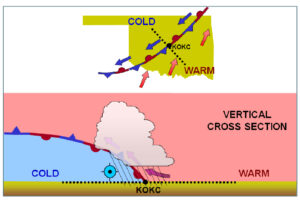 Stationary Front
Stationary Front
In a stationary front end, the forces of the ii air masses are relatively equal; neither air mass is replacing the other, and the purlieus can remain stationary. The conditions associated with a stationary front end is typically a mixture of weather from warm and cold fronts. Pilots tin expect the weather in the expanse to persist for several days, and the surface winds will blow parallel to the frontal zone.
Occluded Forepart
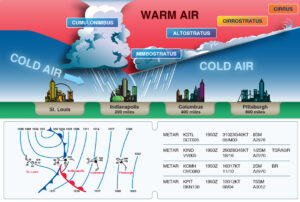 An occluded front occurs when a fast-moving cold forepart catches upward with a slower warm front. It may do good yous to think of an occluded front as three sections – a cold front, a warm forepart, and an area of cool air ahead of the warm front.
An occluded front occurs when a fast-moving cold forepart catches upward with a slower warm front. It may do good yous to think of an occluded front as three sections – a cold front, a warm forepart, and an area of cool air ahead of the warm front.
A cold front occlusion occurs when the fast-moving cold front is colder than the air alee of the dull-moving warm front, resulting in the warm front beingness lifted aloft into the atmosphere. This standoff of different air masses produces a mixture of weather found in both warm and cold fronts.
Conversely, a warm front occlusion occurs when the air ahead of the wearisome-moving warm front is colder than air from the cold front end. When this happens, the common cold front volition be lifted above the expanse of absurd air ahead of the warm front end, causing severe weather with a relatively unstable lapse rate. In such situations, embedded thunderstorms, rain, and fog are likely to occur.
What Can I Do With This Data?
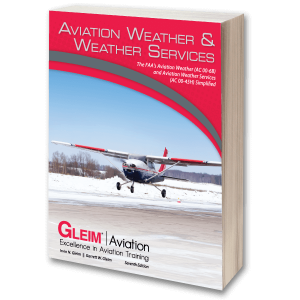 Past understanding the different characteristics of fronts, you can brand more informed flight planning decisions. For example, we understand that common cold fronts are fast approaching with fiddling warning, and they bring almost a complete atmospheric condition change in just a few hours. With this knowledge, analyzing a surface analysis nautical chart may favor delaying an intended flying until the forepart completely passes. If the weather condition is caused past a stationary or occluded front, it may be best to filibuster your departure, since those fronts could take several days before the atmospheric condition becomes conducive to completing your flying.
Past understanding the different characteristics of fronts, you can brand more informed flight planning decisions. For example, we understand that common cold fronts are fast approaching with fiddling warning, and they bring almost a complete atmospheric condition change in just a few hours. With this knowledge, analyzing a surface analysis nautical chart may favor delaying an intended flying until the forepart completely passes. If the weather condition is caused past a stationary or occluded front, it may be best to filibuster your departure, since those fronts could take several days before the atmospheric condition becomes conducive to completing your flying.
Always obtain a conditions briefing earlier each flight. If you lot are unsure of the characteristics or effects of an approaching forepart, a weather briefer can assistance you understand the impending conditions phenomena and associated hazards.
To learn more about fronts and weather systems, reference the Gleim Aviation Weather and Weather Services book!
Written by: Ryan Jeff, Aviation Research Assistant
4 Different Types Of Fronts,
Source: https://www.gleimaviation.com/2020/09/25/four-types-of-fronts/
Posted by: dodsonbeele1989.blogspot.com


0 Response to "4 Different Types Of Fronts"
Post a Comment